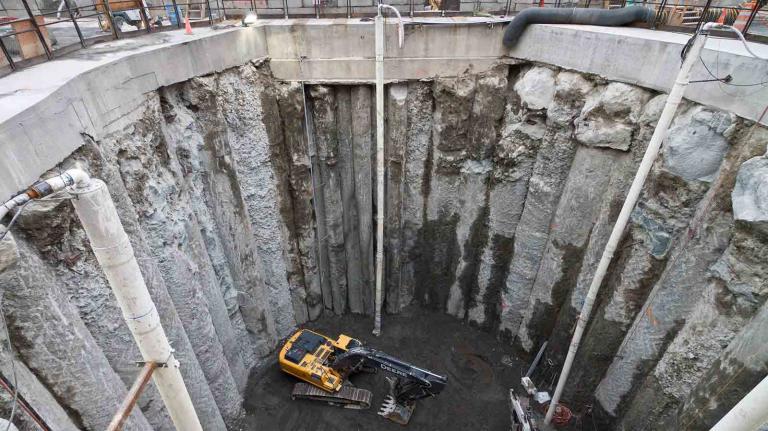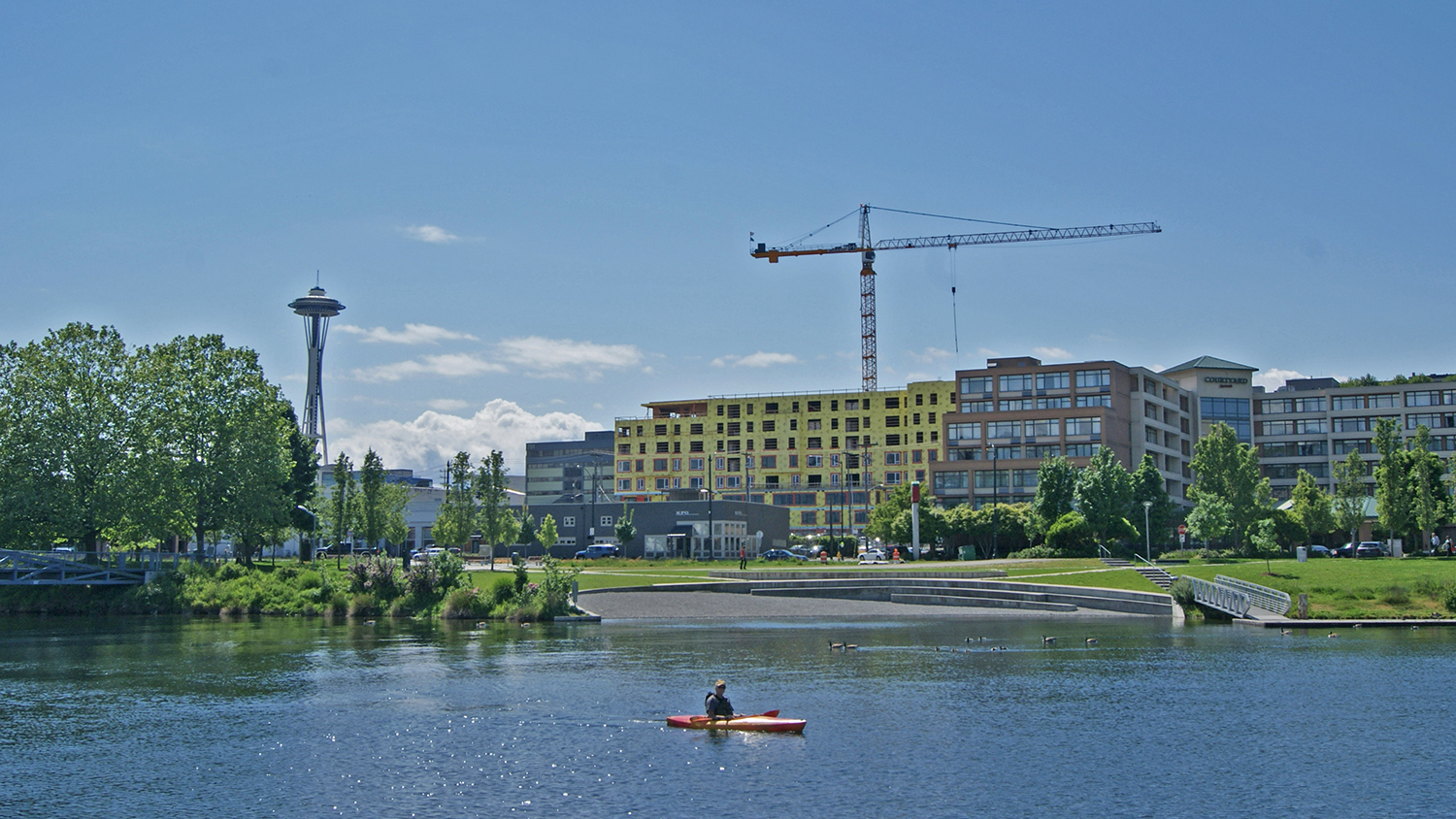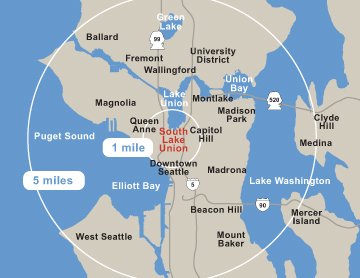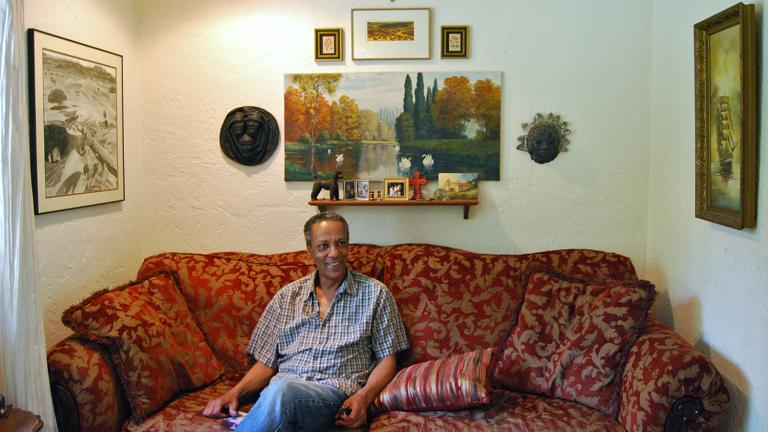South Lake Union is convinced that it is Seattle’s future. It’s easy to see why: Signs advertising new apartments mark every street corner. The place has more construction cranes than a Richard Scarry book. For every office tower, there’s another one rising next to it, half finished — and next to that tower-to-be is a majestic and rectangular hole in the ground, waiting for someone to fill it with concrete.
Back in March, I wrote about the office-park mode of building – a creation of both pastoral fantasy and Cold-War paranoia – and its remarkable endurance, even in the forward-thinking, youth-driven companies of the tech industry. There are some signs that this is changing: Both Google and Facebook have proposed adding housing to their suburban headquarters, which would turn them into something more like a university campus or a factory town. Smaller tech companies and satellite offices of the bigger firms increasingly open up shop in urban districts, like New York’s “Silicon Alley.”
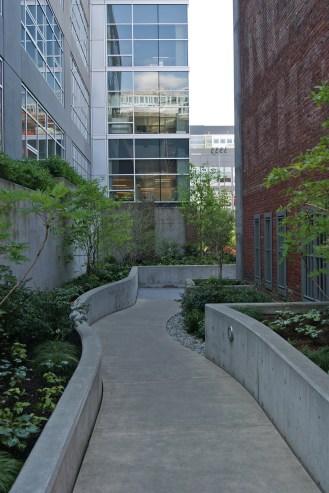
Grist / Amelia Bates
South Lake Union is another stab at rethinking the whole office park tradition. It’s built from scratch, like an office park, but it’s designed to be a part of — and ultimately indistinguishable from — the city around it. It’s intended to be walkable, bikeable, and accessible by public transit. There are no company buses shuttling workers into and out of the neighborhood. But its main employers (Amazon, Fred Hutchinson Cancer Research Center, Group Health, and a University of Washington biotech and research hub) all pay extra money to have the streetcar line down Westlake Avenue run every 10 minutes during rush hour instead of every 15.
Building an urban area from scratch is never easy — especially not in the U.S. I used to live near Emeryville, Calif., an area that — like South Lake Union — had been industrial, before it was torn down and reshaped into a collection of shopping districts and office parks in the ’90s and early 2000s. The shops of Emeryville were the closest thing my West Oakland neighborhood had to a downtown (our original main street had been demolished in the ’60s). But trying to run errands in Emeryville was a nightmare, whether I navigated the area as a pedestrian, a cyclist, or a driver. Developers hadn’t coordinated their work, and car traffic coursed through the area at a throbbing pulse of insanity, with no easy way to bypass it. There were bike paths, but they also doubled as some pretty great ways to get killed by frustrated drivers exiting the IKEA parking lot.
If I squint, South Lake Union looks a lot like Emeryville — and a lot like similar mixed-use developments built in the last two decades across the country. What’s different about it is the way that it connects to the city grid, and the way that it’s built to a pedestrian scale. The parking lots are buried deep underground. The sidewalks are wide, and they aren’t just there for show; at noon on a weekday, they’re full of people walking down the street and chatting with each other. People are walking to the grocery store — in fact, the South Lake Union Whole Foods looks like a mosh pit.

If you want to understand why South Lake Union looks the way it does, look for a small, modernist lean-to at the intersection of Westlake and Denny Way. The building itself — the South Lake Union Discovery Center — is temporary. At some point in the next few years, it will be disassembled and replaced by another multi-story mixed-use building. For now, it houses a massive model of the neighborhood, sprawled out under a printed canopy of robins-egg-blue sky. Lori Mason Curran, the investment strategy director for Vulcan Real Estate, the developer behind much of the neighborhood, gave me a tour of the model with a laser pointer before showing me around the neighborhood in person.
Curran was among Vulcan’s early hires. The company’s goal was to create jobs and bring in city revenue because, as Curran puts it, “cities like that.” “We were getting ready to ask for infrastructure,” she continued, “so we needed to provide these things.” Vulcan finished its first buildings in 2004 — an apartment complex, an infectious disease research center, and the headquarters for Tommy Bahama, a sportswear company. It lobbied Seattle’s government to build a streetcar line down Westlake Avenue. The line would connect the newly developing neighborhood to the edge of Seattle’s downtown — but also allow Vulcan to put in more buildings and less parking.
[grist-related-series]
The streetcar line opened in 2007, and it was a game-changer: Once it started running, the price per square foot for office space along the line doubled. Most of that land was owned by Vulcan. That same year, Amazon announced its decision to set up shop in the neighborhood.
Amazon’s rapid expansion in Seattle has been met with a combination of excitement and unease. Amazon’s founder, Jeff Bezos, brags about its origins in a garage in the suburb of Bellevue, but an early Amazon investor told The Seattle Times that one of the reasons Bezos kept the company in Washington — instead of moving to, say, California — is that he was trying to reduce the likelihood that large numbers of his customers might be required to pay sales tax. Until recently, the company had a reputation as one of the biggest skinflints in Seattle — refusing to even talk to local nonprofits and charities while other hometown companies like Microsoft and Boeing donated millions.
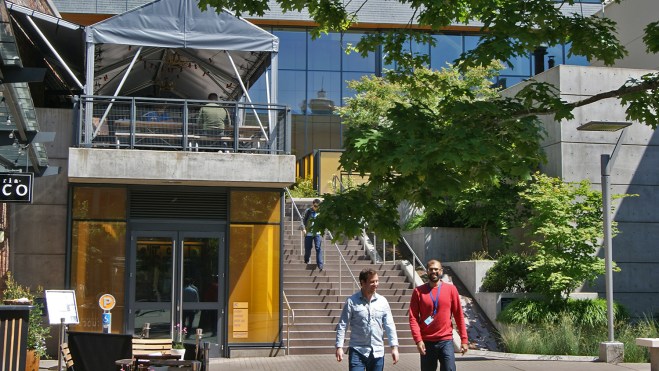
Grist / Amelia Bates
Another reason for unease was the nature of tech itself. Tech companies make such appealing investments because they’re scalable — they can get very big very fast. But scalability, when applied to cities, carries physical and financial risks that can stretch the social and financial fabric of city life to the breaking point. When a company is scaling up, tax revenue rolls in and jobs are easy to come by — but there isn’t enough housing or work space for everyone. When a company scales down, office buildings can empty out overnight, unemployment soars, and funding for social services collapses at exactly the time that it’s needed most. For years after the first dot-com boom in San Francisco went bust at the turn of the millennium, the real estate passions inflamed by virtual companies left a whole lot of very real half-completed mega-construction projects around the city, including several substantial holes in the ground. It also left some very real holes in the city budget, which had been built on tax revenue that no longer existed.
In 2012, Amazon bought all 11 of the buildings it was leasing from Vulcan, making it one of the biggest landowners in Seattle. The purchase came close on the heels of an unexpected about-face in civic-mindedness — Amazon began donating small amounts to various philanthropic groups, and Jeff Bezos, Amazon’s CEO, contributed $10 million to the restoration of the Seattle Museum of History and Industry. Much of the ground floor of the museum is now taken up by the “Bezos Center for Innovation,” and the upper floors display Amazon shipping cartons inside Plexiglas cubes as if they were treasured city relics.
Amazon has already written itself into Seattle’s history, literally. Now — differentiating itself from its two predecessors in regional-corporate dominance, Boeing and Microsoft — it is planting a future in the city itself rather than in the suburbs.

South Lake Union could have happened very differently. In 1991, a Seattle Times columnist named John Hinterberger got an idea. Most U.S. cities in the ’90s had an industrial neighborhood that had been hammered by globalization, but Seattle was unusual for having one so close to downtown. South Lake Union had begun as a forest, then became home to sawmills, and then harbored Seattle’s Model T factory. William Boeing used Lake Union’s waterfront as a testing ground for airplanes. But the years after that were not kind; South Lake Union became a collection of low-slung, mostly prefab buildings that was cut off from the city on two sides by 1960s-era freeway construction (I-5 on the east, State Highway 99 on the west).
What if, wrote Hinterberger, Seattle created a park that would run all the way through South Lake Union, the way that Central Park ran through Manhattan? Seattle didn’t have a major downtown park — this might be the city’s last chance. His vision had a distinctly Pacific Northwest tinge, with a salmon run at its center. To Hinterberger, the project, which was quickly dubbed “The Seattle Commons,” was more than just a park – it was the front line in a larger battle for Seattle’s soul. His descriptions read like a weed-fueled reverie:
Imagine a salmon run in the middle of Seattle.
Imagine new groves of evergreens where once upon a time there was nothing but old groves of evergreens.
In short, imagine the essences of the Northwest – right here in the major urban defoliation of the Northwest.
How absurd.
How delicious.
The idea caught on; there was plenty in the plans for the eco-minded, but also plenty for developers. The park and its spawning salmon would be bordered by high-tech laboratories, condos, and office buildings. Paul Allen, cofounder of Microsoft and 51st wealthiest person in the world, loaned the Seattle Commons $20 million to buy up land at the park’s proposed location.
But to some, the Commons was free like a puppy. To pay for it, the city would have to put up nearly three times what Allen had put on the table – which came out to about $48 per homeowner, every year, for the next nine years. Opponents saw the project as a blatant tactic to boost the value of surrounding properties, and feared it would become a magnet for Seattle’s downtown homeless. As one detractor put it: “It would be a place for the rich and poor paid for by the middle class.”
The Seattle Commons went up for a citywide vote twice – in 1995 and in 1996. Both times it lost, narrowly. According to the deal Paul Allen had struck with the Seattle Commons, if the park didn’t happen, the land he’d put up the cash for would revert to his ownership. After the second defeat, Allen suddenly found himself with a lot of land and no clear plan for it. That’s how Vulcan Real Estate — and, eventually, today’s South Lake Union — was born.

At the edge of South Lake Union, near the waterfront, there is a glass-canopied alleyway between two of Amazon’s buildings. The alleyway is shaped by a public sculpture — “There is Another Sky,” designed by Spencer Finch, who is best known for his work at New York’s 9/11 memorial.
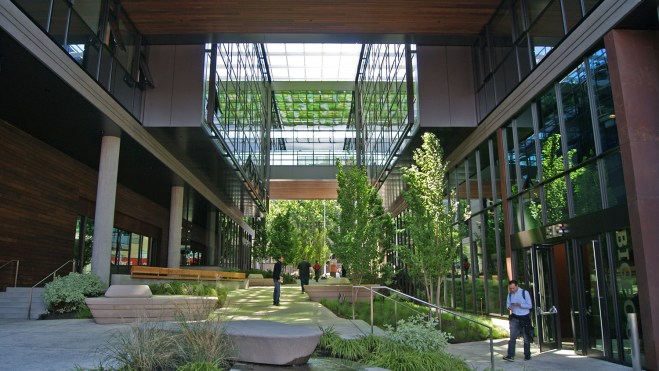
Grist / Amelia Bates
“There is Another Sky” is both perfectly nice and a solid example of the kind of civic/corporate art that dominates this era – vague, inoffensive, and studded with anti-skateboarding modifications. The glass roof is printed with an abstract design that was made to look like a forest canopy, and when the sun sets, LEDs attached to the glass flicker in a way that is meant to simulate fireflies. In cold, rainy weather, you can lie on one of several heated boulders as though you were a lizard, watching the rain fall on the glass and never quite hit you.
Nowhere does the work hint at how close this space came to becoming something else – a place with real trees instead of a modernist abstraction of them. But then, Seattle had its chance to have a park, and the city turned it down. Today, Seattle arguably has more tax revenue than it would have if it had a park to maintain, rather than several city blocks of Vulcan-developed buildings bringing in the Benjamins. And the development in South Lake Union has spurred infill development in other neighborhoods around the city, too. “I just want this city to grow,” Susan Jones, a local architect, told me when I mentioned that many people were unnerved at the pace of development around the city. “Seattle is a suburban town. It can handle the density.”
South Lake Union is better than an office park. But it also doesn’t feel like a real neighborhood. Even with multiple architects designing the buildings, the structures still have a cookie-cutter quality. Nothing is edgy, or glamorous, or even tacky. There’s nothing animating this neighborhood that feels remotely like the freewheeling hippie grandiosity that seemed to animate the creation of the Seattle Commons plan (or the Frank Gehry-designed Experience Music Project — another Allen project). South Lake Union may have its origins in a gift, but today, it’s all business.
Sometimes a boring-looking neighborhood can spruce itself up by having interesting street life, but in South Lake Union, almost everyone is young, and male (Amazon’s workforce in Seattle is 75 percent male), and white (or, less often, Asian). The homogeneity can give the place the quality of an early Twilight Zone episode. I walk for several blocks before I see someone with gray hair. The homeless, omnipresent in downtown Seattle, are mysteriously invisible.
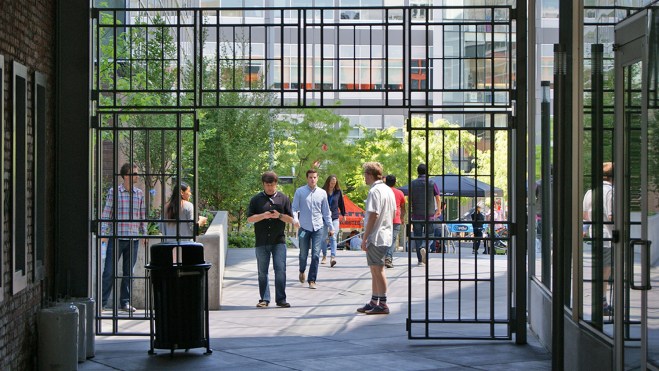
Grist / Amelia Bates
The neighborhood reminds me of another place I’ve been to recently — Google’s campus, in Mountain View, Calif. What’s missing, though, is Google’s upper-class daycare vibe. There are no free bikes abandoned in the grass, no shirtless tetherball games in progress.
You can spot some signs of nearby dot-commery if you know where to look: There’s the permanently installed ping-pong table, with legs made to look like the profiles of different scientists. There are the strategically placed boulders that Amazon employees are instructed to have their dogs pee on, so as not to kill the landscaping. There is a bike share station, and a pillar with a built-in bike pump and hex tools. If, as Vulcan’s planners remind us, millennials will occupy the majority of office chairs come 2030, then South Lake Union, with its pee rocks and ping pong tables, is ready for them.
By nightfall, South Lake Union is empty, except for the crowds around a few restaurants. The area may have room for 43,000 employees, but Vulcan has only built housing for about 1,367 of them, bringing the neighborhood tally up to 6,500. (Another 6,000 apartments, from a variety of developers, are in the works.) And that housing is expensive — while the neighborhood has a modest amount of public and workforce housing, market-rate housing starts at about $1,400 for a studio apartment.
Vulcan’s goal is to build South Lake Union into a 24/7 neighborhood — one where people work, live, and play. Right now, though, it lacks the critical mass of destination spots that its young employees would go to. It’s not surprising that, every night, they desert South Lake Union for neighborhoods like the older, scruffier Capitol Hill, which lies uphill to the east, just over the interstate.
When I walk through Capitol Hill one evening, the effect — despite all the people staggering around me in full drunken-bro mode — is strangely poetic. Every Friday night, the young workers of South Lake Union crawl out of the neighborhood in epic numbers, like salmon trying to spawn.
